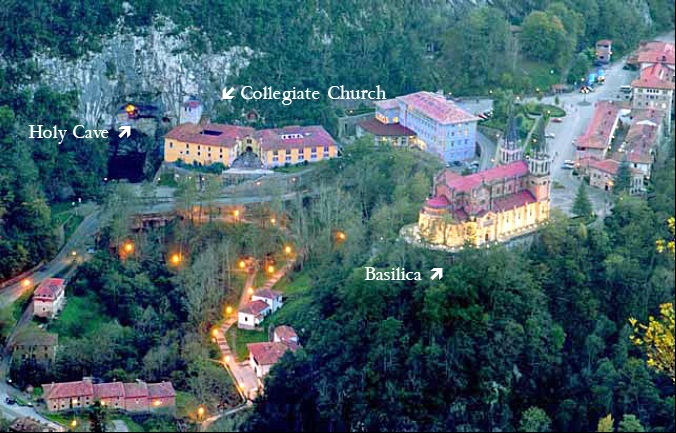

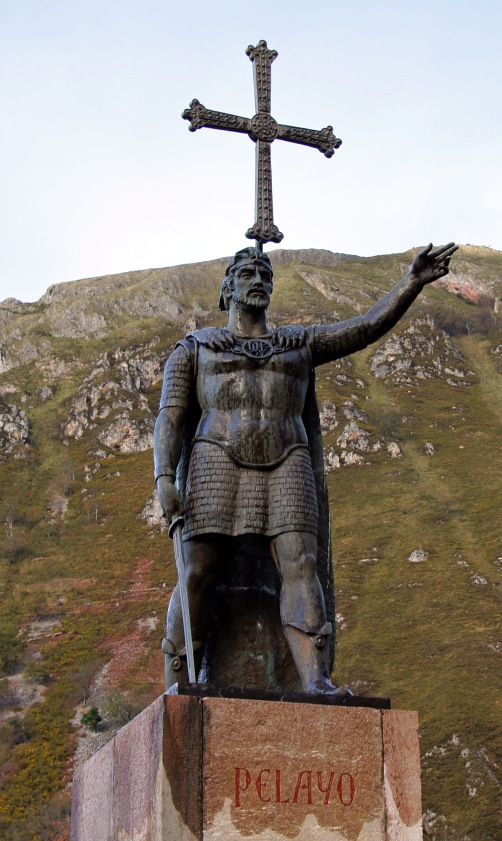 After the rise of Islam in Asia Minor and North Africa, the Moors turned against Spain. The Visigoth Kingdom was weak at
the time, and thus in 711 Moorish troops from North Africa landed without great difficulty in the neighborhood of the present Gibraltar.
In the decisive battle between the Moors and the Visigoths during the same year, the Visigoths were defeated, and their King Rodrigo
fell in the battle. Legends spread throughout the country that Rodrigo had not actually perished but had perhaps become a hermit;
or, if he died, he appeared in different forms to strengthen his vanquished people.
After the rise of Islam in Asia Minor and North Africa, the Moors turned against Spain. The Visigoth Kingdom was weak at
the time, and thus in 711 Moorish troops from North Africa landed without great difficulty in the neighborhood of the present Gibraltar.
In the decisive battle between the Moors and the Visigoths during the same year, the Visigoths were defeated, and their King Rodrigo
fell in the battle. Legends spread throughout the country that Rodrigo had not actually perished but had perhaps become a hermit;
or, if he died, he appeared in different forms to strengthen his vanquished people.
The remnants of the beaten Visigoth army scattered in panic. Only one man, Don Pelayo, a kinsman of the defeated monarch,
did not despair. He slowly retired with groups of courageous knights and soldiers into the dark hills and mountains of Asturias,
where they hid themselves around a place known as Covadonga (which may mean deep cave
or cave of the Lady
).
When they arrived in this hiding place, Don Pelayo wanted to discipline an unruly member who fled the group.
Pelayo pursued him and was about to take him prisoner, when a hermit appeared before him in front of one of the caves.
He told Pelayo that he should honor that cave as a sanctuary, according asylum to the fleeing criminal. If you pardon the culprit now,
you will find a haven one day at the same spot and thus remake the Empire,
said the hermit. Pelayo knew that the cave from time
immemorial had been considered a sanctuary of the Madonna, whose image (see home page) was venerated
there by the hermits, and so he pardoned the man.
The tiny kingdom
of Don Pelayo extended for only ten miles in any direction, but it was a summit that stood clear
above the tide that had submerged the rest of Spain. His defiance of Moslem rule must have seemed almost futile and insignificant,
but the Moslems eventually learned of it and sent a large army to crush the Christian resistance.
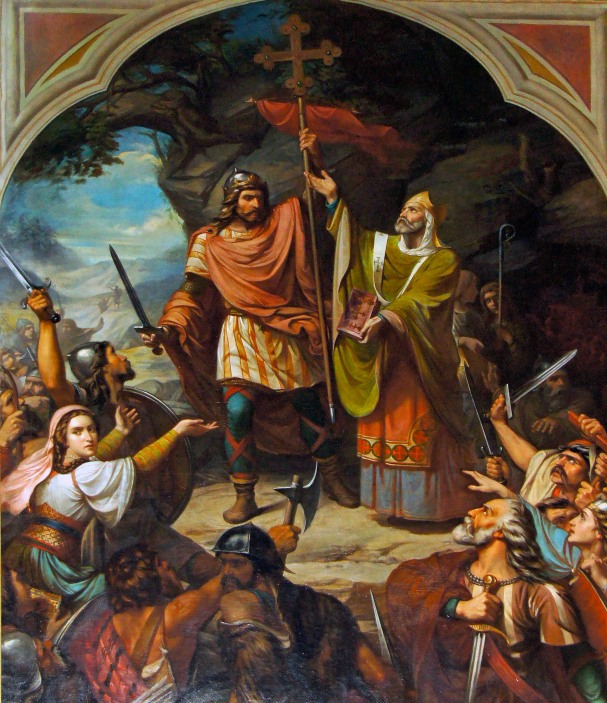 It was the spring of the year 722, a little over ten years before Charles Martel's unforgettable stand at Tours, when the Moors finally
appeared in the valley to dislodge Pelayo from his lofty peak. Thousands upon thousands of Moslem warriors scaled the steep slopes
toward the cave in which Pelayo awaited them. With the Moors was a traitor to God, King and country – the reprobate Bishop Oppas.
He was sent ahead to convince Pelayo to give up rather than fight. The details of their conversation were remembered and recorded as follows:
It was the spring of the year 722, a little over ten years before Charles Martel's unforgettable stand at Tours, when the Moors finally
appeared in the valley to dislodge Pelayo from his lofty peak. Thousands upon thousands of Moslem warriors scaled the steep slopes
toward the cave in which Pelayo awaited them. With the Moors was a traitor to God, King and country – the reprobate Bishop Oppas.
He was sent ahead to convince Pelayo to give up rather than fight. The details of their conversation were remembered and recorded as follows:
Pelayo was on Mount Auseva with his people, and the army arrived and pitched their innumerable tents at the entrance of the cave.
Upon a mound facing the holy cave, Bishop Oppas spoke: Pelayo, Pelayo, where are you?
Whereupon Pelayo, from an opening in the cliff,
responded: Here I am.
The bishop continued: I believe that you understand how the entire army of the Visigoths cannot resist the
force of the Moors; how then can you resist on this mountain? Listen to my advice: abandon your efforts and you will enjoy many benefits
alongside the Moors.
Pelayo responded: Have you not read in Scriptures that the Church of the Lord is like the mustard seed,
which, small as it is, grows more than any other through the mercy of God?
The bishop responded: Truly, so it is written.
And Pelayo said: Our hope is in Christ; this little mountain will be the salvation of Spain and of the people of the Visigoths;
the mercy of Christ will free us from that multitude.
The Bishop returned to the Moors to report his failure. The defense of Spain was left to Pelayo and his men. Realizing the danger, Don Pelayo went to the sanctuary of the Madonna. Remembering the words of the hermit, he prayed in the cave and solemnly vowed to win a victory or die in battle. Then Pelayo, together with his three hundred men, prayed to the Blessed Virgin Mary for Her assistance and intercession before God, as the power of Islam was about to be unleashed against them. They obtained Her favor in a very remarkable way.
The following day the Moors advanced to kill Pelayo and destroy any last vestige of resistance to their rule in Spain. As soon as they were within range, the Moors began to fire arrows and other projectiles at Pelayo and his men. The arrows and stones turned, however, and came crashing down upon the ones who fired them. Pelayo’s men sent boulders down upon their enemy, and started avalanches that swept many of them away. Although they initially fled, the Moslems were not to be easily overcome, and soon regrouped for another attack. As the Moors advanced a second time, again they were treated to a shower of rocks and boulders while the sky darkened at the approach of a thunderstorm, bursting with lightning and heavy rain. At first the rain made the rocks treacherous and slippery, but as it continued it loosened the stones and cast them down upon the ill-fated Moors. Still, for every one who fell there were two to take his place.
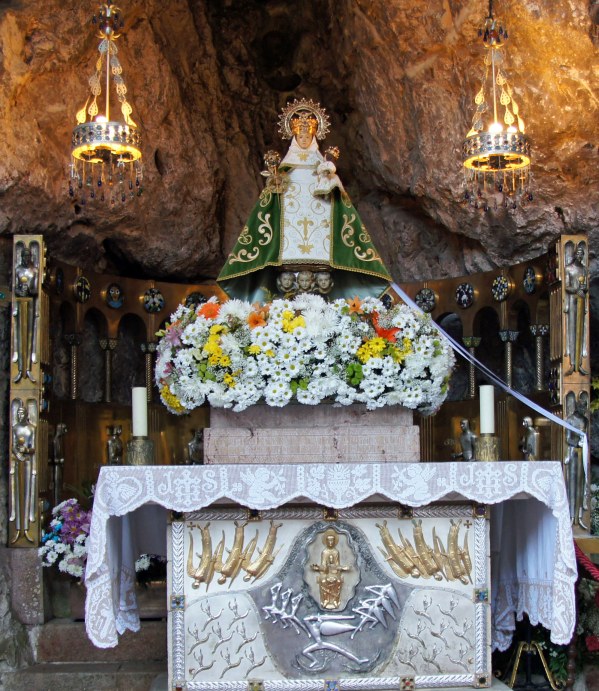 Suddenly a strange light appeared in the cave of Covadonga, and in its midst the Mother of God appeared to Pelayo and his beleaguered men.
Speaking to Pelayo, She said,
Suddenly a strange light appeared in the cave of Covadonga, and in its midst the Mother of God appeared to Pelayo and his beleaguered men.
Speaking to Pelayo, She said, Arouse thy strength; go forth in the name of Jesus Christ, and thou shalt conquer.
Having delivered Her message, the Mother of God disappeared and the supernatural illumination faded. Had the Moors seen the light
from the mouth of the cave? Were they so blind that they could not see that God was with Pelayo and his men?
The very earth, sky and the elements themselves were full of enmity against them! When Pelayo emerged from the darkness of the cave
a moment later, his eyes blazed with resolve. Filled with newfound confidence, his men swept out from the cave to hurl the Moors
from the slopes. Thwarted by the fury of the thunder storm, their precarious hold on the mountain fast giving way beneath their feet,
the Moors fled for their lives as they perceived their approaching doom. Pelayo's men rushed upon them, and with renewed conviction
sent down more arrows and boulders after them, and many more were carried away to their death. When the survivors reached the floor
of the valley below, the River Deva had been turned into a raging torrent that swept still more away.
Thanks to Our Lady of Covadonga, Pelayo's victory was such that the Moors were completely driven from the mountain, with not one surviving to tell the tale of their utter destruction. General Alqama was slain, and Governor Munuza met the same fate upon entering the Asturias. Never again did the Moors dare to enter Pelayo's domain.
In time, perhaps due to the example of Pelayo's heroic resistance, other Catholic kingdoms developed in the north of the peninsula. The kingdom of Pelayo, called the Asturias, grew into León, and the other kingdoms included Castile, Navarre, Catalonia, Galicia, and Aragon. King Pelayo's heroic resistance was the beginning of the nearly 800 year crusade known as the Reconquista, or reconquest, of Spain.
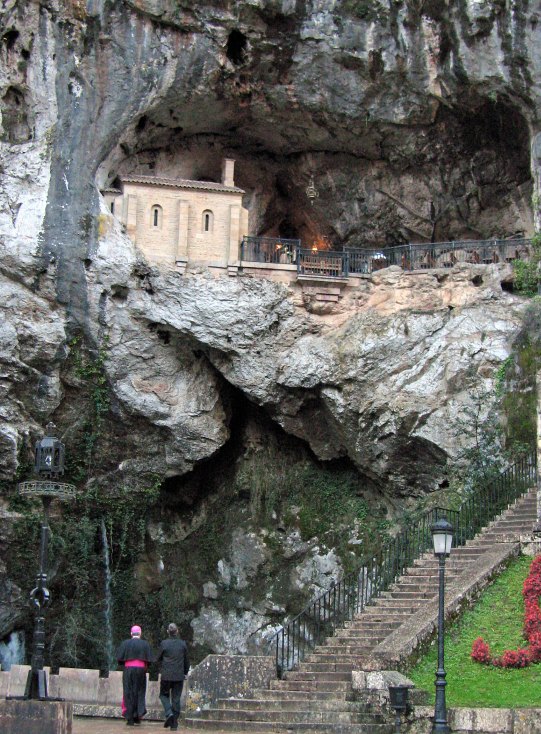 It was King Pelayo's successor and son-in-law, King Alfonso I (called
It was King Pelayo's successor and son-in-law, King Alfonso I (called the Catholic
), who ordered the first church and Benedictine
monastery to be built at Covadonga. Both of these Kings are buried at the Shrine, as well as Pelayo's daughter and Alfonso's wife, Hermelinda.
The original monastery underwent several renovations – at the end of the 16th century, Felipe IV built an Augustinian collegiate church on the
site of the old monastery, under the title of San Fernando. After further renovations, it remains the oldest building of the Sanctuary complex –
due to the fact that the original church and shrine chapel were destroyed by fire in the 18th century.
Unfortunately the original image of Our Lady of Covadonga – known affectionately as La Santina – also perished in that fire. It was replaced by a very beautiful copy, which remains to this day. The copy of La Santina was stolen in 1939 and taken to Paris during the Spanish Civil War. History does not suggest that the statue was desecrated. She was instead held hostage by someone, with the hope of gaining a top military or political rank in return for Her release. The exchange never happened, however. The polychrome wooden image was found by chance after the war by the Spanish ambassador in Paris, Pedro Abadal. Wasting no time, the ambassador reported his finding and crossed the Spanish border with the statue in his own car, ensuring She was returned safely to Her rightful place in the chapel in the Santa Cueva (Holy Cave).
After the fire mentioned above, King Carlos III ordered a monumental national shrine church to be built at the Sanctuary of Covadonga, but construction was delayed by a century, until the reign of King Alfonso XII. Finally on September 11, 1901 the neo-Gothic church of Santa Maria la Real de Covadonga was named a Basilica by Pope Leo XIII. From the esplanade of the Basilica, the Holy Cave can be reached by a tunnel. But pilgrims often prefer to approach the Santa Cueva by the Stairway of Promises – consisting of 103 steps, which the more devout ascend on their knees.
The image of Our Lady of Covadonga was solemnly crowned by the Archbishop of Toledo in the presence of King Alfonso XIII and Queen Victoria Eugenia on September 8, 1918. Indeed, ever since the victory of Pelayo, the Virgin of Covadonga has become one of the greatest symbols of the Spanish nation.
Alphabetical Index; Calendar List of Saints
Contact us: smr@salvemariaregina.info
Visit also: www.marienfried.com